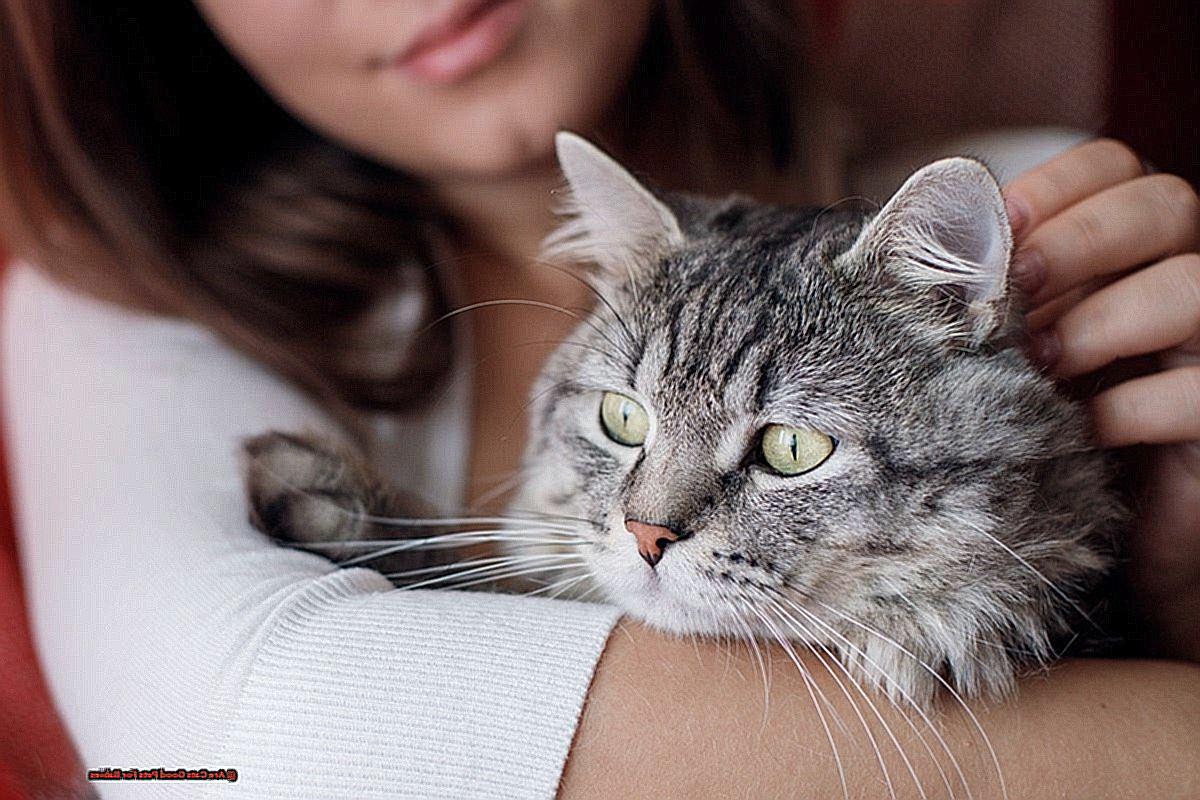The age-old question of whether cats make good pets for babies has been a hot topic among pet owners and parents alike.
While some swear by the companionship and benefits of having a feline friend in the house, others raise concerns about potential risks and dangers. As a devoted cat lover and soon-to-be parent myself, I couldn’t help but wonder – are cats truly safe and suitable pets for babies?
With extensive research and expert consultations, I’ve uncovered some surprising facts and insights on this intriguing topic. In this blog post, we’ll delve into the pros and cons of having a cat around a baby, as well as crucial considerations to keep in mind before welcoming one into your family.
So let’s dive in.
Are Cats Good Pets For Babies?
Contents
But before you make your decision, there are some important things to consider. In this post, we’ll explore whether cats can be good pets for babies and provide expert advice on how to make the experience safe and enjoyable for everyone involved.
- The Personality Factor: Every cat is unique, just like every child. While some cats may be more tolerant and affectionate towards babies, others may be more independent and less interested in human interaction. It’s crucial to consider your cat’s personality before bringing them into a household with a baby. If your cat is easily startled or has shown aggression towards other animals or people, they may not be the best fit for a household with a baby.
- Low Maintenance Pet: One of the benefits of having a cat as a pet is their low maintenance nature. Unlike dogs, cats don’t require daily walks or constant attention. This can be appealing for busy parents with young children. However, it’s important to remember that cats still need love and care, such as regular grooming and playtime. Make sure you have the time and energy to devote to your cat’s needs, even with a new baby in the house.
- Introducing Your Cat to Your Baby: Proper introductions are key when bringing a new pet into your household, especially when there’s a baby involved. Cats can be sensitive to sudden movements and loud noises, so it’s important to introduce them to your baby slowly and carefully. Allow your cat to approach the baby at their own pace and supervise their interactions closely. If your cat shows any signs of discomfort or aggression towards the baby, separate them immediately.
- Teaching Proper Interaction: Just as we teach our children how to behave around other people, it’s important to teach them how to interact with animals, including cats. Gentle petting, avoiding pulling on fur or tail, and not disturbing a sleeping cat are all important lessons to teach your child. This will not only ensure a positive relationship between your child and your cat, but also promote empathy and kindness towards animals.
Teaching Responsibility and Empathy through Pet Ownership
You want to raise your child to be a responsible and empathetic individual. But did you know that owning a cat can be a powerful tool in teaching these important life skills? Yes, you read that right – your feline friend is more than just a fluffy companion, they can also be a valuable teacher to your child.

Research has shown that children who grow up with pets tend to have higher levels of responsibility, empathy, and self-esteem. And what better pet to have than a cat – known for their low-maintenance nature and independent personalities.
So how exactly can owning a cat help your child develop responsibility and empathy? Let’s take a closer look.
Daily Responsibilities:
One of the first things your child will learn when owning a cat is daily responsibilities. From feeding and grooming to cleaning up after their furry friend, these tasks teach children the importance of taking care of another living being. They will also learn about the importance of routine and consistency in caring for their pet.
Empathy through Observation:
Cats are experts at showing emotions through their behaviors. By watching their cat’s body language, children can learn to understand their needs and emotions. This teaches them empathy – the ability to understand and share the feelings of others. They will learn to be gentle and patient with their pet, as well as how to recognize when their cat is happy, scared, or in need of attention.
Compassion and Putting Others First:
Taking care of a pet also teaches children the importance of putting others’ needs before their own desires. By making sure their cat is fed, groomed, and loved, they learn compassion towards others. This can translate into how they interact with other people and animals in their lives.
Positive Effects of Pet Ownership on Children’s Social and Emotional Development
You want the best for your child, and that includes their social and emotional development. While there are many ways to support your child’s growth, one often overlooked source is owning a pet cat. As an expert on the positive effects of pet ownership on children, I can confidently say that cats make excellent companions for kids.
Let’s dive into the research and discover the benefits of owning a cat for your child’s social and emotional well-being.
The Power of Companionship: Why Cats Make Great Pets for Children
Cats may have a reputation for being independent creatures, but they can also be incredibly loving and affectionate companions. Studies have shown that children who grow up with pets, including cats, tend to have better social skills and are more empathetic towards others. This is because cats provide unconditional love and companionship, which can have a powerful impact on a child’s emotional well-being.
Teaching Life Skills: How Owning a Cat Can Benefit Your Child’s Development
Taking care of a pet is a big responsibility, but it also teaches children valuable life skills. From feeding and grooming to cleaning the litter box, children learn how to be responsible and take care of another living being. This can translate into better organizational skills, time management, and even empathy towards animals.
Empathy and Self-Esteem: The Impact of a Strong Bond with a Pet Cat
Cats are known for forming strong bonds with their owners, and this can be incredibly beneficial for a child’s emotional development. One study found that children who had a strong attachment to their pet cat showed higher levels of empathy and self-esteem compared to children without pets. This is because cats provide comfort and support, especially during times of stress or anxiety.
Why Cats Can Be Low Maintenance Pets for Busy Parents with Young Children
As a busy parent with young children, you may be hesitant to add a pet to your already hectic household. After all, pets require time, attention, and care – things that you may feel like you have in short supply. But what if I told you that there is a pet option that can bring joy and companionship to your family without adding additional stress to your life? That’s right, I’m talking about cats.
Cats have a reputation for being independent creatures, and this makes them a great pet option for busy parents with young children. Here are some reasons why cats can be low maintenance pets for your family:
Independent by Nature
Unlike dogs, cats do not require regular walks or outdoor playtime. They are content to entertain themselves indoors with toys or by simply napping. This means that you don’t have to worry about scheduling time for daily walks or finding a pet sitter when you’re away from home.
Minimal Grooming Needs
Cats also have a natural instinct for grooming, so they rarely need to be bathed. This can be a huge relief for parents who already have their hands full with caring for a baby. Additionally, most cats are diligent groomers and keep themselves clean and tidy on their own.
Flexible Diet
In terms of feeding, cats also have a more flexible diet compared to other pets. They can thrive on a variety of commercial cat food brands and even some human food in moderation. This means that you don’t have to worry about preparing special meals for your cat or constantly buying expensive food.
Fewer Health Concerns
Compared to dogs, cats tend to have fewer health concerns and require less frequent vet visits. This can save busy parents both time and money. Of course, it’s still important to keep up with routine check-ups and vaccinations, but you can breathe a little easier knowing that your cat is generally a healthy and low-maintenance pet.
Quiet Companions
Cats are generally quiet animals, making them less likely to disturb a sleeping baby or cause loud commotion in the house. This means that you can enjoy some peace and quiet while your little ones nap or play.
Proper Introductions and Supervision: Bringing a Cat into a Household with a Baby
Introducing your furry feline friend to your new bundle of joy can be an exciting and nerve-wracking experience. As a cat owner and a new parent, it’s natural to have concerns about how your cat will react to the newest addition to the family.
But fear not, with proper preparation and supervision, you can create a harmonious environment for both your cat and baby. As an expert on introducing cats to babies, I’ve gathered some valuable insights and practical tips to help guide you through this process.
First and foremost, it’s essential to prioritize your baby’s safety. This means setting up physical barriers such as baby gates or screens to keep your cat out of the baby’s room or designated play area. It’s also crucial to educate yourself and any other family members on proper handling and interaction with cats to avoid any potential accidents or injuries.
Supervision is key when it comes to introducing your cat to your baby. This means being physically present and attentive at all times during interactions between the two. Even the most well-behaved cats can exhibit unpredictable behavior in new situations, so it’s important to always be prepared for unexpected reactions.
If possible, try to introduce your cat to your baby gradually. Start with short supervised visits and gradually increase the duration as they become more comfortable with each other. It may also be helpful to have another adult present during these interactions to provide additional support and assistance if needed.
Remember that every cat is different and may react differently to a new baby in the household. Some may become more affectionate while others may become more aloof. By taking the time to properly introduce them and providing ongoing supervision, you can help set the foundation for a positive relationship between your cat and baby.
Addressing Concerns about Allergies in Cats and Babies
One of the biggest concerns when welcoming a new baby into the household is the potential for allergies. Many people believe that having a cat in the house can trigger allergies in babies and young children. However, research has shown that the opposite may actually be true.
Studies have found that early exposure to cats can actually help prevent allergies and asthma in children. This is because exposure to allergens at a young age can help strengthen a child’s immune system and reduce their risk of developing allergies later on in life.
Of course, every child is different and may react differently to cats. If your baby already has known allergies, it’s important to consult with your pediatrician before introducing a cat into your household. They can provide personalized advice on how to safely introduce your cat to your baby and minimize potential allergy triggers.
In addition to consulting with your pediatrician, there are also steps you can take to minimize potential allergy triggers in your home. These include keeping the cat out of the baby’s room, regularly grooming and bathing your cat, and using air purifiers or HEPA filters to reduce allergens in the air.
For families with severe allergies, hypoallergenic cat breeds may be an alternative option. These breeds produce less of the protein in their saliva that can trigger allergies in humans. Some popular hypoallergenic breeds include the Siberian, Balinese, and Sphynx cats.
It’s also important to prioritize proper hygiene for both your cat and baby. Regularly cleaning the litter box and washing your hands after handling your cat can help prevent any potential allergic reactions. And just like with humans, regular check-ups with a veterinarian can ensure that your cat is healthy and free of any underlying conditions that may cause allergies.
Signs to Look for in a Cat’s Behavior that May Indicate Aggression towards a Baby
We all want our pets to get along with our little ones, but it’s important to be aware of potential warning signs of aggression. As an expert on cat behavior, I’m here to share some tips on how to identify and address any aggressive behavior towards babies in your beloved cat.
One of the most common signs of aggression in cats is excessive hissing or growling towards the baby. This can be a sign that your cat feels threatened or uncomfortable around the new addition to the household. It’s important to pay attention to your cat’s body language and intervene if you notice this behavior.
Another red flag is if your cat starts swatting at the baby with its paws or becomes overly possessive of its toys or food when the baby is around. This can be a sign of jealousy or territorial behavior, and it’s essential to address it before it escalates.
Some cats may also display aggressive body language, such as flattened ears, dilated pupils, and an arched back, when in the presence of a baby. These are all signs that your cat is feeling stressed or threatened, and it’s important to take action.
If you notice any of these behaviors in your cat, it’s crucial to seek professional help from an animal behaviorist. They can provide guidance on how to properly train and socialize your cat with the baby and help address any underlying issues that may be causing the aggression.
It’s also essential for parents to teach their babies how to interact with cats properly. This includes not pulling on their tails or ears and not trying to pick them up without adult supervision. Teaching children how to respect animals can go a long way in preventing any potential accidents or injuries.
It’s recommended to supervise interactions between cats and babies at all times, especially in the early stages. If necessary, it may be best to keep the cat separated from the baby until they are both older and can interact safely.
Remember, with proper training and socialization, most cats can learn to coexist peacefully with babies. However, it’s important to always prioritize the safety of both the baby and the cat and seek professional help if needed. By paying attention to your cat’s behavior and taking necessary precautions, you can ensure a happy and harmonious relationship between your furry friend and your little one.
Conclusion
In conclusion, the age-old question of whether cats make good pets for babies has sparked many debates and discussions. As a devoted cat lover and expectant parent, I was determined to uncover the truth behind this controversial topic. Through extensive research and consultations with experts, I have gained valuable insights and knowledge.
It is important to evaluate your cat’s personality before bringing them into a household with a baby. While some cats may be gentle and affectionate towards infants, others may not be suitable due to their independent nature or past aggressive behavior.
Despite these considerations, owning a cat can have numerous benefits for a child’s development. From teaching responsibility and empathy to promoting communication and social skills, cats can serve as valuable teachers for children.
For busy parents with young children, cats can be low maintenance pets that provide companionship without adding additional stress to their already hectic lives. However, proper introductions and supervision are crucial when introducing a new cat into a household with a baby. The safety of the baby should always be the top priority, and it is essential to educate both children and adults on how to interact with cats properly.
Allergies in cats and babies have also been addressed in this debate. While early exposure to cats may actually help prevent allergies in children, it is still important to consult with a pediatrician if your baby has known allergies. Taking proper hygiene measures can also help minimize potential allergens in the home.
Lastly, parents must pay attention to any signs of aggression from their cat towards the baby. Seeking professional help from an animal behaviorist is recommended if necessary. By teaching children how to respect animals and closely monitoring interactions between cats and babies, we can ensure a harmonious relationship between our furry friends and little ones.
In conclusion, while there are certain considerations and precautions that need to be taken into account when considering having a cat as a pet for your baby, the benefits can outweigh any potential risks when proper care is taken. With love, patience, and proper management, cats can make wonderful companions for babies and contribute positively to their social and emotional development.






